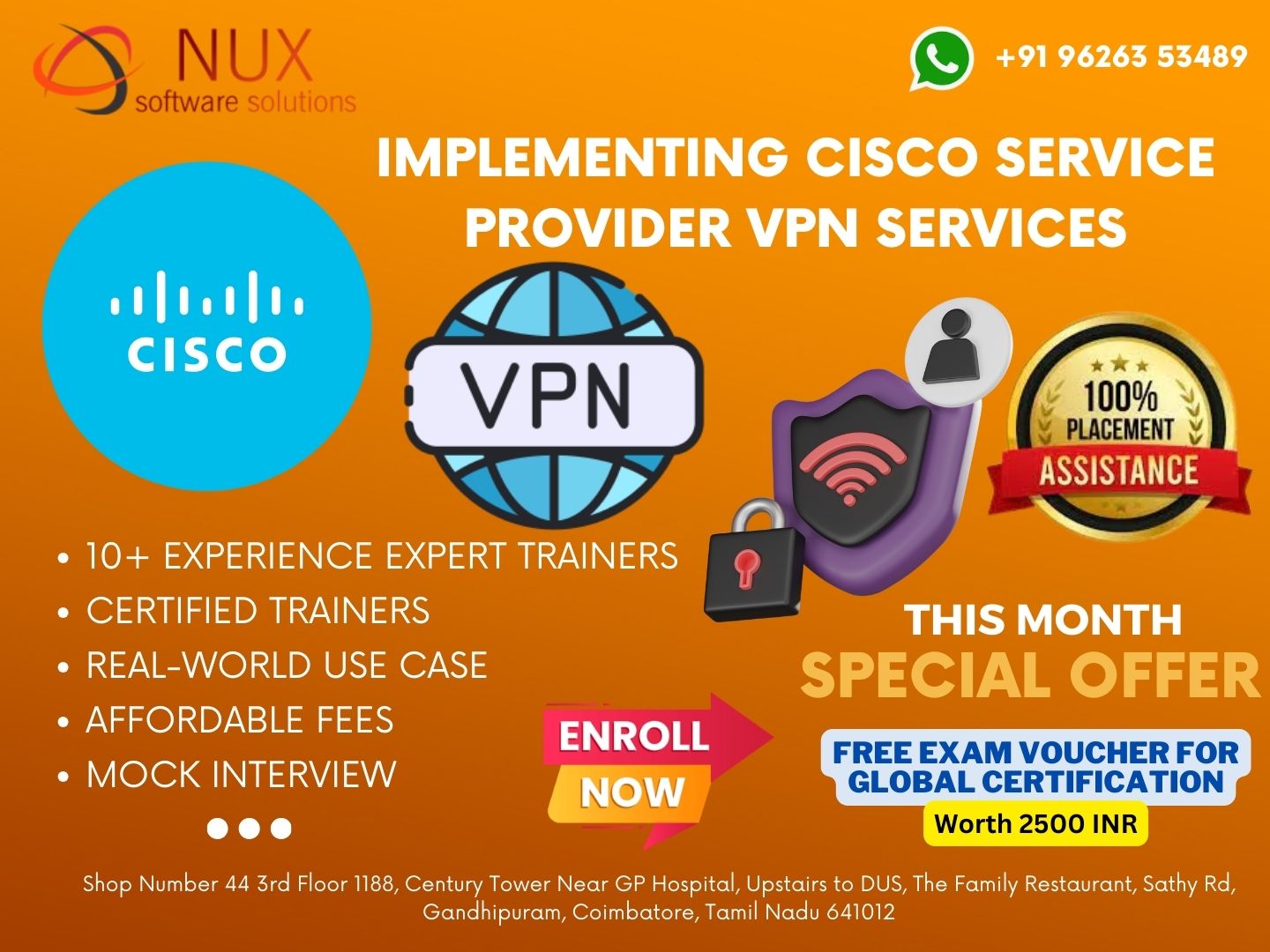Implementing Cisco Service Provider VPN Services

Implementing Cisco Service Provider VPN Services (SPVI) Training in Coimbatore
Course Overview
The Implementing Cisco Service Provider VPN Services (SPVI) course provides essential knowledge and practical skills required to design, implement, and troubleshoot MPLS VPN solutions in a service provider environment. It’s part of the Cisco Service Provider certification track, and focuses on deploying scalable and secure VPN services using MPLS technologies.
At Linux Training Center in Coimbatore, our SPVI training is tailored to equip networking professionals with the capabilities to manage large-scale service provider networks. This course offers hands-on lab exercises, real-world use cases, and expert-led training sessions to help learners become proficient in configuring Layer 2 and Layer 3 VPNs, MPLS, and BGP.
Why Choose SPVI?
MPLS VPNs are the backbone of enterprise-grade service provider offerings. The SPVI course enables engineers to support managed network services for customers over a single infrastructure. It provides deep insight into the operation of Layer 2 (L2VPN) and Layer 3 (L3VPN) services and how these are implemented using MPLS and BGP.
This training is critical for those aiming to become Cisco Certified Specialist – Service Provider VPN Services or pursue the CCNP Service Provider certification.
Who Should Enroll?
The SPVI course is ideal for:
Service provider network engineers
NOC engineers and support professionals
Network architects and designers working in ISP environments
Candidates pursuing Cisco CCNP Service Provider certification
Professionals responsible for VPN service delivery and customer connectivity
Prior knowledge of IP routing, MPLS concepts, and Cisco IOS XR or IOS XE is recommended.
What You Will Learn
MPLS VPN architecture and core components
Configuration and deployment of Layer 3 MPLS VPNs using MP-BGP
Implementing Layer 2 VPNs (L2VPN) including AToM and VPLS
MPLS label distribution and forwarding mechanisms
Understanding route targets, route distinguishers, and VRFs
Inter-AS and Carrier Supporting Carrier (CSC) solutions
Monitoring and troubleshooting MPLS VPNs
Managing scalability, security, and redundancy in VPN deployments
This course aligns with real-world service provider requirements and includes lab simulations for hands-on expertise.
Course Highlights
Instructor-led training by Cisco-certified SP engineers
Lab-based curriculum using actual Cisco IOS XR or XE environments
Covers full SPVI exam blueprint and hands-on practice
Real-time use cases and practical configuration walkthroughs
Flexible scheduling: online, weekday, and weekend classes
Post-course mentoring support for certification and job preparation
Career Opportunities
Completing the SPVI course opens up roles such as Service Provider Network Engineer, IP/MPLS Engineer, VPN Solutions Specialist, Core Network Architect, or Network Design Engineer. It’s especially relevant to ISPs, telecoms, and organizations offering managed network services.
Why Linux Training Center?
Linux Training Center in Coimbatore provides career-focused Cisco training with a strong foundation in both theory and real-world labs. Our SPVI training ensures that learners are fully prepared to implement and maintain high-performance MPLS VPN networks that meet the needs of modern service providers.
Implementing Cisco Service Provider VPN Services Syllabus
VPN Architecture - 25%
- Compare VPN architecture
- Layer 2 and Layer 3 VPN
- Inter-AS and Intra-AS
- Troubleshoot underlay
- Core IGP
- LSP
- Describe Layer 2 service architecture
- IOS XR Ethernet Flowpoints
- IOS XE Ethernet Virtual Circuits
- Describe the L3VPN control plane operation
- MP-BGP
- Route distinguisher
- VPNv4 address
- Route target
- VPN label
- VRF routing instance
- PE-CE route advertisement
- Describe the L3VPN data plane operation
- Underlay label
- VRF forwarding instance
Layer 2 VPNs - 30%
- Troubleshoot L2VPN Services
- E-LAN
- E-Line
- E-Tree
- Describe EVPN concepts
- Data plane and control plane operation
- Multihoming mechanisms
- Suppression mechanisms
- Traffic forwarding operation
- Implement Ethernet Operations, Administration, and Maintenance (E-OAM)
- Implementing EVPN
- EVPN IRB
- EVPN VPWS
- EVPN native
Layer 3 VPNs - 35%
- Describe routing requirements
- MP-BGP
- PE-CE routing protocol
- Troubleshoot Intra-AS L3VPNs
- PE-CE
- PE-PE
- PE-RR
- Implement multicast VPN
- Intranet MVPN
- Extranet MVPN
- MLDP
- Implement extranet/shared services
- Import and export route targets
- Route policy
- Describe Inter-AS L3VPNs
- Option A
- Option B
- Option AB
- Option C
- Describe CSC concepts
IPv6 VPNs - 10%
- Describe routing requirements
- MP-BGP
- PE-CE routing protocol
- Troubleshoot IPv6 VPN provider edge
- PE-PE
- PE-CE



